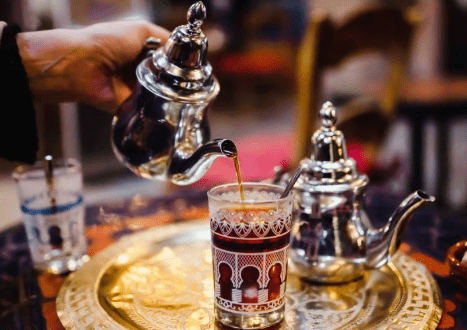By Islam Salah
Tea is much more than just a drink in the Middle East. It plays a key role in social interactions, hospitality, and even health practices. With centuries of tradition behind it, the beverage has become a symbol of generosity and care.
Let’s explore tea’s cultural significance and health benefits and find out why it’s so popular in the Middle East!
A Sip of History: How Tea Came to the Middle East
The story of tea began in ancient China, where it was prized for its healing properties. As trade along the Silk Road expanded, tea made its way to the Middle East, where it quickly took root in everyday life.
By the 15th century, teahouses were established, turning tea into a symbol of hospitality, social status, and community, a tradition that continues today.
The Language of Hospitality: Why Tea Matters
Tea plays a central role in Middle Eastern culture as a powerful symbol of hospitality. Offering a cup to guests is an important ritual, one that conveys warmth and respect—and refusing it can be seen as impolite.
It’s a way to break the ice and make visitors feel welcome and at home. Besides that, there’s no set time for tea; you can enjoy it at any point throughout the day, whether it’s after a meal or during a casual visit.
Serving tea also comes with its own customs: it’s often poured from a height to enhance its flavor, creating a frothy, aromatic finish. Plus, special occasions call for higher-quality tea, a gesture that highlights generosity.
Tradition in Every Sip: Types of Middle Eastern Teas
Middle Eastern teas come in a variety of flavors, each with its own significance:
- Classic Black Tea: A strong, versatile drink that’s widely consumed throughout the region, sometimes served with milk or sugar for a rich, comforting experience.
- Saidi Tea: A much stronger version of classic black tea served with sugar and is a favorite in rural communities like Upper Egypt.
- Mint Tea (Shay bi-l-na’na): Refreshing and soothing, often served after meals to aid digestion.
- Cardamom Tea (Hal): Typically enjoyed before meals, it helps prepare the digestive system and is loved for its rich aroma.
- Chamomile Tea (Babunaj): Calming and relaxing. This tea is perfect for alleviating stress and promoting sleep.
Health in a Glass: The Science Behind the Tea
Tea offers more than just a soothing taste; it’s packed with countless health benefits. Rich in antioxidants, the beverage is often praised for its anti-aging properties.
Plus, tea has been shown to improve blood circulation, boost the immune system, and may help with weight loss. That’s not even to mention the caffeine kick the beverage gives you, making it the perfect way to start the day. Other than that, herbal varieties like sage tea promote digestion, while mint tea is widely used to combat colds and flu.
Tea Across Generations: Adapting Tradition
While traditional flavors remain at the heart of Middle Eastern tea culture, modern blends now incorporate traditional ingredients with global wellness trends, such as rose-infused chai and Ayurvedic teas, offering a mix of ancient remedies and contemporary health benefits.
Drinks like mint-citrus and saffron teas reflect evolving tastes. Despite these innovations, tea continues to play a central role in family gatherings, business meetings, and social events, bridging generations and keeping the tradition alive.
Brewing Tradition and Connection
Tea in the Middle East isn’t just a drink; it’s a tradition that brings people together. Whether for hospitality, health, or simply a moment of relaxation, the beverage plays a key role in daily life. As the region grows, the love for tea remains strong, keeping connections alive across generations!
WE ALSO SAID: Don’t Miss…Panera Bread’s New, Naturally Flavored Fruit Beverages Are Heaven in a Cup



